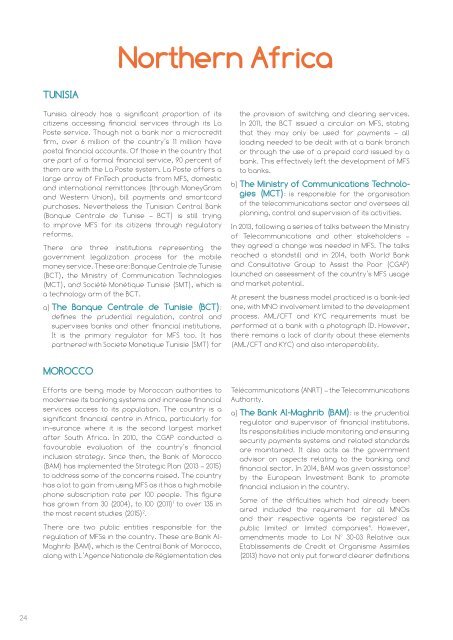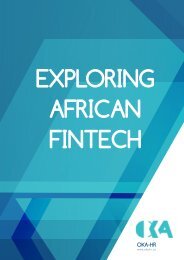FiA_2015
You also want an ePaper? Increase the reach of your titles
YUMPU automatically turns print PDFs into web optimized ePapers that Google loves.
Northern Africa<br />
TUNISIA<br />
Tunisia already has a significant proportion of its<br />
citizens accessing financial services through its La<br />
Poste service. Though not a bank nor a microcredit<br />
firm, over 6 million of the country’s 11 million have<br />
postal financial accounts. Of those in the country that<br />
are part of a formal financial service, 90 percent of<br />
them are with the La Poste system. La Poste offers a<br />
large array of FinTech products from MFS, domestic<br />
and international remittances (through MoneyGram<br />
and Western Union), bill payments and smartcard<br />
purchases. Nevertheless the Tunisian Central Bank<br />
(Banque Centrale de Tunise – BCT) is still trying<br />
to improve MFS for its citizens through regulatory<br />
reforms.<br />
There are three institutions representing the<br />
government legalization process for the mobile<br />
money service. These are: Banque Centrale de Tunisie<br />
(BCT), the Ministry of Communication Technologies<br />
(MCT), and Société Monétique Tunisie (SMT), which is<br />
a technology arm of the BCT.<br />
a) The Banque Centrale de Tunisie (BCT):<br />
defines the prudential regulation, control and<br />
supervises banks and other financial institutions.<br />
It is the primary regulator for MFS too. It has<br />
partnered with Societe Monetique Tunisie (SMT) for<br />
the provision of switching and clearing services.<br />
In 2011, the BCT issued a circular on MFS, stating<br />
that they may only be used for payments – all<br />
loading needed to be dealt with at a bank branch<br />
or through the use of a prepaid card issued by a<br />
bank. This effectively left the development of MFS<br />
to banks.<br />
b) The Ministry of Communications Technologies<br />
(MCT): is responsible for the organisation<br />
of the telecommunications sector and oversees all<br />
planning, control and supervision of its activities.<br />
In 2013, following a series of talks between the Ministry<br />
of Telecommunications and other stakeholders –<br />
they agreed a change was needed in MFS. The talks<br />
reached a standstill and in 2014, both World Bank<br />
and Consultative Group to Assist the Poor (CGAP)<br />
launched an assessment of the country’s MFS usage<br />
and market potential.<br />
At present the business model practiced is a bank-led<br />
one, with MNO involvement limited to the development<br />
process. AML/CFT and KYC requirements must be<br />
performed at a bank with a photograph ID. However,<br />
there remains a lack of clarity about these elements<br />
(AML/CFT and KYC) and also interoperability.<br />
MOROCCO<br />
Efforts are being made by Moroccan authorities to<br />
modernise its banking systems and increase financial<br />
services access to its population. The country is a<br />
significant financial centre in Africa, particularly for<br />
in¬surance where it is the second largest market<br />
after South Africa. In 2010, the CGAP conducted a<br />
favourable evaluation of the country’s financial<br />
inclusion strategy. Since then, the Bank of Morocco<br />
(BAM) has implemented the Strategic Plan (2013 – <strong>2015</strong>)<br />
to address some of the concerns raised. The country<br />
has a lot to gain from using MFS as it has a high mobile<br />
phone subscription rate per 100 people. This figure<br />
has grown from 30 (2004), to 100 (2011) 1 to over 135 in<br />
the most recent studies (<strong>2015</strong>) 2 .<br />
There are two public entities responsible for the<br />
regulation of MFSs in the country. These are Bank Al-<br />
Maghrib (BAM), which is the Central Bank of Morocco,<br />
along with L’Agence Nationale de Réglementation des<br />
Télécommunications (ANRT) – the Telecommunications<br />
Authority.<br />
a) The Bank Al-Maghrib (BAM): is the prudential<br />
regulator and supervisor of financial institutions.<br />
Its responsibilities include monitoring and ensuring<br />
security payments systems and related standards<br />
are maintained. It also acts as the government<br />
advisor on aspects relating to the banking and<br />
financial sector. In 2014, BAM was given assistance 3<br />
by the European Investment Bank to promote<br />
financial inclusion in the country.<br />
Some of the difficulties which had already been<br />
aired included the requirement for all MNOs<br />
and their respective agents be registered as<br />
public limited or limited companies 4 . However,<br />
amendments made to Loi N° 30-03 Relative aux<br />
Etablissements de Credit et Organisme Assimiles<br />
(2013) have not only put forward clearer definitions<br />
24





